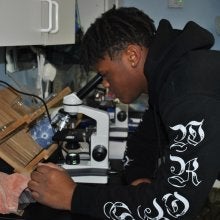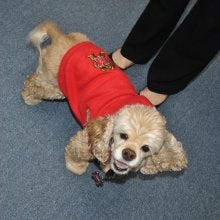Alumni Spotlight: Linda Jacobs (‘62, M.A. ’65, Ph.D. ’71), Founder of Acclaimed Special Education School
As an undergraduate at the University of Maryland, Linda Jacobs initially majored in history and minored in mathematics.
“I wanted to teach difficult kids to love history,” Linda Jacobs said, in an interview at her office at The Harbour School’s Annapolis-based campus.
However, her undergraduate advisor let her know that a new faculty member, Jean Hebeler, would be joining the University of Maryland and creating a minor in special education. Since Dr. Jacobs did not want to teach math and did want to teach “difficult” children, her advisor recommended she switch her minor to the new field of special education.
Dr. Jacobs was among the first undergraduates in special education at UMD and, due to a lack of history jobs when she graduated, she reluctantly accepted a position teaching special education upon graduation with the intention of switching to teaching history. And yet, the challenge of teaching special education has held her attention throughout her lengthy career.
“It’s hard,” Dr. Jacobs said, when asked what appealed to her about teaching this population. “I get bored very easily. This is my 56th year as a certified special education teacher and I’ve never been bored.”
After completing her undergraduate degree at UMD, Dr. Jacobs taught special education in Baltimore County for two years and then returned to the UMD College of Education to obtain her master’s and doctorate degrees. She returned to Baltimore County as a special education supervisor before going back to UMD. She then joined the College’s special education department as a faculty member, where she taught for seven years.
Dr. Hebeler, however, played yet another pivotal role in Dr. Jacobs’ life, as she had convinced her to get certified as an administrator during her doctoral program. This led to Dr. Jacobs’ next phase in her career, leaving UMD to become the director of special education in Anne Arundel County, prior to transitioning into serving as the assistant state superintendent for the Maryland State Department of Education for three years.
When working in state-level administration, Dr. Jacobs missed interacting with children. At that time, an important shift was taking place in terms of the legal right of children to access special education services, as children with special education needs previously were placed on waiting lists to receive services.
At the suggestion of the president of the Maryland State Board of Education, she left MSDE in 1979 to teach parents their rights under the new legislation, called the Education of All Handicapped Children (EHA), that governed special education.
The parents Dr. Jacobs worked with during this time encouraged her to start a school focused on special education.
What was to become the highly-respected The Harbour School, which now has locations in Annapolis and Baltimore and a total enrollment of 353 students, began in 1982 with four kids and one teacher.
“I wanted to do special education right,” Dr. Jacobs said of her motivation to start a school. For her, one hallmark of doing special education right means not physically restraining children.
“We don’t have one method of teaching kids. Each child has a method of learning and we teach to how they learn—that’s key. I’ve got a lot of square pegs and we don’t make any of them go in a round hole.”

The two campuses have approximately 200 staff members for 353 students, and Dr. Jacobs has created incentives to retain staff, such as a loan for teachers to obtain their master’s degree in special education that is paid off by the staff member after completion of five years of teaching.
“I look for passion in special education teachers,” Dr. Jacobs said. “I can teach you the technical skills of being a teacher, but if you don’t have the instinct, I can’t make you a good teacher.”
One other source of passion displayed at The Harbour School is Dr. Jacobs’ love of the University of Maryland. The Harbour School, which features brightly colored murals throughout the building that feature painted scenes of library shelves and a car wash—and the entrance to the gym has been transformed to resemble Cole Field House.

“We do let the kids watch TV if the Terps are in the championships. But if they’re losing, they’re leaving,” she said.


